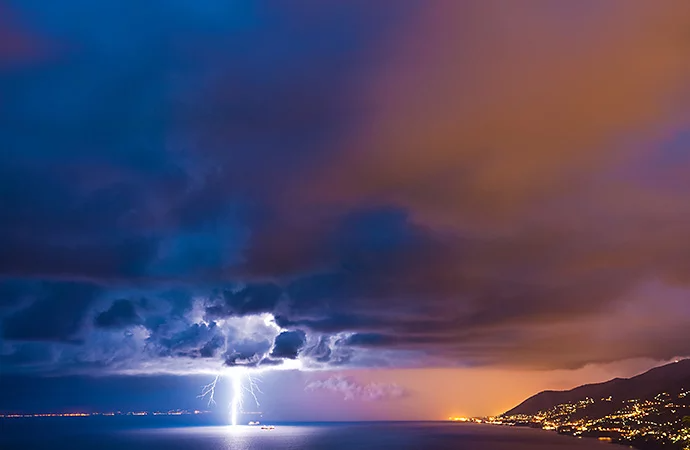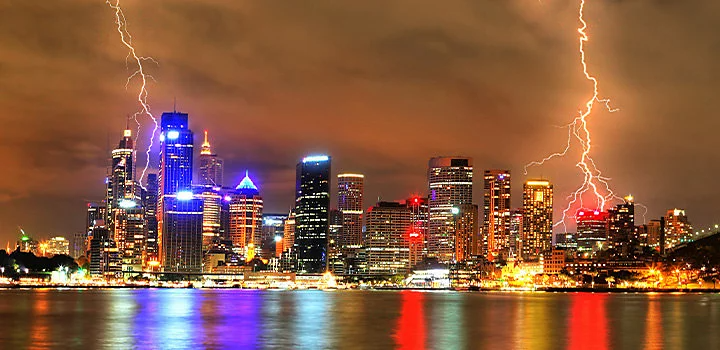Photography
اكتشف العالم المثير من التصوير الفوتوغرافي للعاصفة والبرق.
تعلم كيفية تصوير البرق والبقاء آمنًا أثناء التقاط صور العواصف. بالإضافة إلى ذلك، اكتشف أفضل الإعدادات والأدوات اللازمة للحصول على صور مذهلة للبرق ولقطات للطقس القاسي.

Photography
تعلم كيفية تصوير البرق والبقاء آمنًا أثناء التقاط صور العواصف. بالإضافة إلى ذلك، اكتشف أفضل الإعدادات والأدوات اللازمة للحصول على صور مذهلة للبرق ولقطات للطقس القاسي.
حوّل صور العاصفة الخاصة بك من مقبولة إلى رائعة عن طريق ضبط إعداد واحد للكاميرا: التعرض الضوئي. اضبط تعرضًا ضوئيًا أطول لالتقاط أكبر عدد ممكن من صور صواعق البرق أو تعرضًا ضوئيًا أقصر للتركيز على صاعقة واحدة.
إن عدم القدرة على التنبؤ بالبرق والعواصف يجعل منها عناصر تصوير مثيرة. الصور المذهلة التي تلتقط صواعق البرق والصور الفريدة للعواصف تبهر المشاهدين ويمكن أن تساعد أيضًا في دراسة الطقس. يقول المصور نيك أوليفيري: "لا يوجد صاعقتان متماثلتان على الإطلاق". "إنه عرض لقوة الطبيعة مثير للاهتمام حقًا، والتقاط هذا أمر مثير." اكتشف مُطارد العواصف والمصور جيسون وينجارت حالات شاذة مثل تفريغ البلازما على كاميرته. يقول: "لن تعرف أبدًا نوع الحدث النادر الذي ستلتقطه". ولكن قبل أن تبدأ، ابحث حتى تتمكن من الحصول على اللقطة المثالية مع البقاء بعيدًا عن الأذى.


الأمان هو الشغل الشاغل لأي نوع من تصوير العواصف أو البرق. يقول مصور الطقس والبيئة جيم ريد: "إذا كنت تستطيع سماع الرعد، فأنت معرض لخطر الإصابة بصاعقة البرق". "في بعض الحالات، لا تحتاج حتى إلى سماع صوت الرعد."
بادر بإعداد الكاميرا الخاصة بك باستخدام جهاز التصوير عن بُعد بواسطة كابل أو أداة تحفيز البرق حتى تتمكن من التصوير من سيارتك أو من مبنى مجاور. بينما السيارات آمنة إلى حد ما، فإنك "لن تكون بأمان تام إلا إذا كنت داخل مبنى ولا تلمس أي شيء متصل بمقبس كهربائي أو سباكة"، وفقًا لما قاله وينغارت.
إذا كان يجب أن تكون بالخارج، فتجنب أن تكون أطول شيء في المحيط ولا تقف تحت أطول الأشياء أيضًا، مثل الأشجار أو خطوط الكهرباء. إذا أُصيبت شجرة قريبة، فقد ينتقل التيار إليك أو قد تنفجر الشجرة. إذا لم تتمكن مطلقًا من الدخول في الوقت المناسب، فقف على أطراف أصابعك مع الانحناء للأسفل؛ على أن تكون منخفضًا قدر الإمكان، مع تقليل الاتصال بالأرض أيضًا.
تطبيقات الرادار مثل RadarScope أو RadarOmega لا تمكنك من العثور على العاصفة فحسب، بل يمكنها أيضًا الحفاظ على سلامتك. راقب موقع العاصفة وتحقق كثيرًا من التغييرات في السرعة أو الاتجاه. إذا كنت في سيارة، فكن متيقظًا بشأن المكان الذي تتوقف فيه وتنتقل إليه. لا تُضحي بسلامتك لالتقاط صورة.
ابحث عن موقع يمكنك من خلاله التقاط صور للعواصف من مسافة 5 إلى 20 ميلاً. تعتبر هذه المسافة أكثر أمانًا ويمكن أن توفر صورًا أكثر جاذبية. يقول وينجارت: "غالبًا ما يكون هيكل العاصفة بأكمله الذي يضيء من مسافة بعيدة أجمل من أن تكون تحته مباشرة، حيث تقع ضربة البرق على بعد نصف ميل فقط".
باستخدام تطبيق الرادار وموقع ويب National Weather Service، تعرّف على الاتجاه الذي ستأتي منه عاصفتك وحدد الموقع مع أخذ التكوين في الاعتبار. "أحاول الوصول إلى مكان آمن حيث يكون منظر المدينة بيني وبين العاصفة. "بهذه الطريقة يمكنني مراقبة تطور شكل العاصفة عندما تقترب"، يقول أوليفيري. إذا تمكنت من العثور على مكان مرتفع آمن، فسيضيف ذلك أيضًا بعض الإثارة إلى صور صواعق البرق.

يعد الحامل ثلاثي القوائم ضروريًا لتجنب الضبابية عند تصوير البرق، خاصة مع فتح الغالق من أجل تعرض ضوئي أطول. قبل تصوير عاصفة رعدية، استثمر في حامل ثلاثي القوائم مستقر يقلل من اهتزاز الكاميرا. يمكنك أيضًا استخدام جهاز إطلاق الغالق عن بعد بواسطة كابل لتشغيل الصورة دون الحاجة إلى لمس زر الغالق، مما يزيد من التقليل من فرصة حدوث التشويش.
خلال العواصف النهارية، ستحتاج إلى تعرض ضوئي أقصر وفتحة أضيق لتجنب تشويش الصورة. يمكن أن تساعدك أداة تحفيز البرق عن طريق إيقاف تشغيل الغالق عندما يستشعر وميض البرق، مما يسمح بتعريضك للضوء بسرعة. في الظلام، جرب التقاط تعرضات ضوئية طويلة متكررة باستخدام جهاز تحكم بالفواصل الزمنية، الذي سيقوم بتشغيل غالق الكاميرا بانتظام على فترات منتظمة.
يعد استخدام عدسة واسعة الزاوية طريقة رائعة لالتقاط شكل العاصفة بالكامل في لقطة واحدة - ولكن تأكد من حمايتها. حتى لو كنت على بعد أميال من العاصفة، فقد يكون هناك هطول للأمطار. احتفظ بالكاميرا الخاصة بك تحت المظلة أو قم بالتصوير من داخل سيارتك لتبقى جافة.



ستعتمد إعداداتك المثالية لتصوير البرق على كمية الضوء المحيط ومدى قربك من العاصفة. "بعض البروق مشرقة جدًا وقد تخرج عن إطار كاميرتك، والبعض الآخر لا يفعل ذلك. ستحتاج إلى ضبط الكاميرا وفقًا لذلك"، كما يقول ريد. "إنه تغير مستمر في ضبط التعرض الضوئي." إذا كان هدفك هو التقاط أكبر عدد ممكن من الصواعق، فإن التعرضات الضوئية الأطول هي المفتاح لذلك. يعد التعرض الضوئي الأقصر (بمساعدة أداة تحفيز البرق) هو الأفضل لالتقاط صاعقة واحدة من البرق.
ابدأ بالخطوات الموضحة أدناه، ثم قم بتجربة تحسين التصوير الفوتوغرافي للعواصف.

تصوير جاسون وينجارت.

تصوير جاسون وينجارت.
اتبع هذه النصائح لإبراز أفضل ما في صور العواصف ولقطات البرق باستخدام Lightroom.
1. اضبط توازن اللون الأبيض. صوّر في وضع RAW، ثم قم بضبط توازن اللون الأبيض بمجرد استيراد الصورة إلى Lightroom للتعويض عن الظلال غير المرغوب فيها أو التلوين.
2. عدّل التعرض والإبرازات والظلال. حرّك التعريض الضوئي بطريقة أو بأخرى إذا بدا معطلاً. اخفض درجة الإبرازات لاستعادة المناطق المحترقة من البرق.
3. اضبط نقاط اللون الأبيض والأسود. حسّن تباين الصورة دون فقدان أي من التفاصيل في الإبرازات أو الظلال. افعل ذلك عن طريق ضبط مقياس الدرجات اللونية وضبط نقاط اللون الأبيض والأسود.
4. استخدم أدوات Texture (النسيج)، Clarity (الوضوح)، وDehaze (إزالة الضباب). أبرز المشهد الدرامي في السماء باستخدام الشريط المُنزلق Texture (النسيج). استخدم الشريط المُنزلق Clarity (الوضوح) وأداة Dehaze (إزالة الضباب) لتحسين وضوح صورتك.
5. زيادة الحيوية. استخدم الشريط المنزلق للحيوية لإضافة التشبع إلى الدرجات اللونية المتوسطة لصورتك وتحسين اللون في السماء، بالإضافة إلى المناظر الطبيعية ومناظر المدينة خلف العاصفة.

إذا كان لديك عدة لقطات جيدة للبرق من نفس الزاوية بالضبط، فيمكنك إنشاء صورة مركبة تظهر جميع الصواعق مرة واحدة. افتح Adobe Photoshop وقم بوضع صورك فوق بعضها البعض كطبقات منفصلة. ثم قم بتعيين وضع المزج لكل طبقة على أنه "تفتيح". يؤدي هذا إلى بقاء الأجزاء الأكثر سطوعًا في كل طبقة من -البرق- مرئية.
تصوير العواصف يحتفل بكيفية تعبير جونا الجوي المعقد عن الضوء والألوان. ومن المهم توثيق التغيرات في الطقس لدينا. ولكن قبل أن تبدأ في تصوير العواصف، قم بتعلم المخاطر المحتملة واستشر الخبراء حتى تتمكن من البقاء في أمان. "حدد موضوعك"، كما يقول ريد. "هذا جزء من احترام الطبيعة." وكن مستعدًا لأي مفاجآت. "هناك دائمًا فرصة أنك سترى شيئًا لم تره من قبل. إنها تجربة مثيرة، خصوصًا إذا كانت العاصفة جيدة وتتذكر أن تفك غطاء العدسة."
المساهمون
Based on your location, we think you may prefer the United States website, where you'll get regional content, offerings, and pricing.